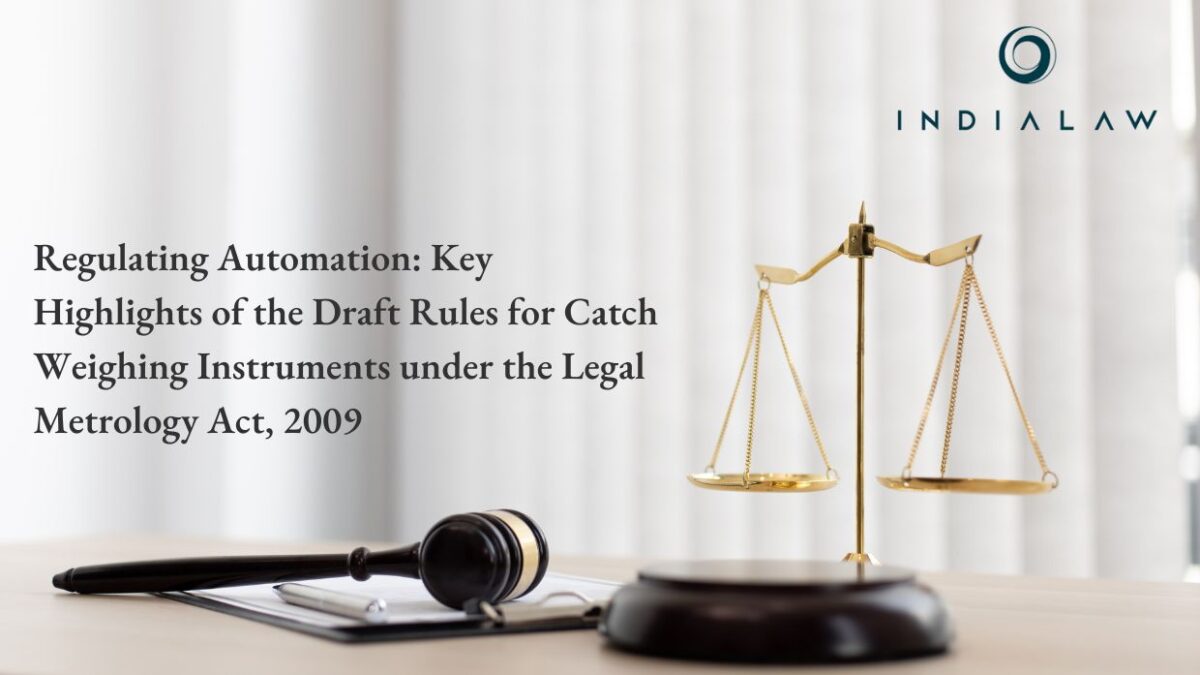Regulating Automation: Key Highlights of the Draft Rules for Automatic Catch Weighing Instruments under the Legal Metrology Act, 2009


Introduction
The Government of India has recently introduced the Draft Rules for Automatic Catch Weighing Instruments (ACWIs) under the Legal Metrology Act, 2009. These proposed regulations aim to ensure accuracy, fairness, and reliability in automated weighing operations across industries like retail, logistics, and waste management. By setting comprehensive standards for construction, operation, and testing, the rules pave the way for enhanced trade practices and strengthened consumer protection in an era increasingly dominated by automation.
General Background
Automatic Catch Weighing Instruments (ACWIs) are devices that automatically determine the weight of discrete or loose loads, playing a critical role in maintaining fairness and accuracy in commercial transactions. With the growing adoption of automated technologies in trade and manufacturing, these draft rules seek to address gaps in existing regulations while integrating modern technological advancements. The initiative reflects the government’s commitment to fostering efficiency, transparency, and consumer confidence in market transactions.
Statutory Provisions
The draft rules are framed under Section 52 of the Legal Metrology Act, 2009, which empowers the Central Government to establish regulations for ensuring accuracy in trade measurements and prescribing standards for weighing instruments. This legal framework underscores the importance of metrological accuracy as a cornerstone of fair trade and consumer protection.
Key Highlights of the Draft Rules
- Instrument Classification:
- ACWIs are categorized based on accuracy (e.g., classes X and Y) and specific applications, such as checkweighers, weigh-labelers, and vehicle-mounted systems.
- Subcategories like XI, XII, and Y(I) are defined to address diverse industrial needs.
- Technical and Metrological Standards:
- Detailed specifications for construction, stability, durability, and sensitivity are outlined.
- Standards for zero-setting, tare functions, and compensation for dynamic effects during weighing are included.
- Markings and Identification:
- Instruments must display essential markings such as manufacturer details, operational limits, and accuracy class.
- Testing and Verification:
- Prescribed procedures for testing accuracy, span stability, and resistance to environmental influences like temperature and tilt.
- Mandatory simulation and operational tests for type approval.
- Implementation Timeline:
- The rules are expected to come into force on July 1, 2025, providing stakeholders ample time for compliance.
Suggestions on the Draft Rules
- Clarity on Multi-Purpose Instruments:
- The draft should explicitly address instruments with dual applications, such as those operating as both checkweighers and weigh-price labellers, to avoid regulatory ambiguities.
- Integration of Advanced Technology:
- Incorporating provisions for AI-driven and IoT-enabled weighing systems could future-proof the rules and encourage innovation.
- Simplified Compliance Mechanism:
- The government should consider a centralized digital portal for streamlined approval, testing, and certification processes.
- Stakeholder Awareness:
- Conducting workshops and training programs for manufacturers and operators will ensure better understanding and adherence to the rules.
- Periodic Review:
- The rules should include a provision for periodic review to adapt to technological advancements and evolving trade practices.
Conclusion
The Draft Rules for Automatic Catch Weighing Instruments signify a progressive step towards modernizing India’s trade and measurement standards. By emphasizing accuracy, transparency, and reliability, the rules aim to protect consumer rights and boost business confidence. The government’s consultative approach, inviting stakeholder feedback, ensures that the regulations will be robust and inclusive. As the world moves towards automation, these rules represent a vital framework for balancing innovation with accountability, fostering a fair and efficient marketplace for all.
The deadline for submitting feedback is January 8, 2025. Stakeholders are encouraged to engage actively, as their inputs will play a crucial role in shaping the final regulations.
For further details write to contact@indialaw.in




